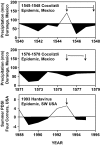Megadrought and megadeath in 16th century Mexico
- PMID: 11971767
- PMCID: PMC2730237
- DOI: 10.3201/eid0804.010175
Megadrought and megadeath in 16th century Mexico
Abstract
The native population collapse in 16th century Mexico was a demographic catastrophe with one of the highest death rates in history. Recently developed tree-ring evidence has allowed the levels of precipitation to be reconstructed for north central Mexico, adding to the growing body of epidemiologic evidence and indicating that the 1545 and 1576 epidemics of cocoliztli (Nahuatl for "pest") were indigenous hemorrhagic fevers transmitted by rodent hosts and aggravated by extreme drought conditions.
Figures



References
-
- Cook SF, Simpson LB. The Population of Central Mexico in the Sixteenth Century. Ibero Americana Vol. 31, Berkeley: University of California Press; 1948.
-
- Gerhard P. A guide to the historical geography of New Spain. Norman, OK: University of Oklahoma Press; 1993.
-
- Hugh T. Conquest, Montezuma, Cortez, and the Fall of Old Mexico. New York: Simon and Schuster; 1993.
-
- Acuna-Soto R, Caderon Romero L, Maguire JH. Large epidemics of hemorrhagic fevers in Mexico 1545-1815. Am J Trop Med Hyg. 2002. In press. - PubMed
Publication types
MeSH terms
LinkOut - more resources
Full Text Sources
Medical
